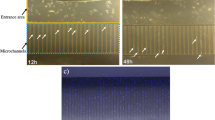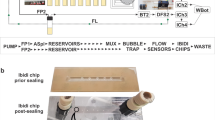Abstract
Despite progress in research and treatment, the prognosis for patients with gliomas remains relatively dismal. As such, develop a new in vitro model is fast becoming a necessary step in efforts to improve research on malignant gliomas. Microfluidics, a potentially effective tool, has been increasingly applied in neuroscience and oncology studies. However, gliomas, the most common primary brain tumours, have not yet been treated with this application. In the current study, we developed a glioma-related research method using microfluidics. After successfully culturing rat C6 glioma cells for up to 7 days in a microfluidic device, we monitored cellular responses to the anticancer drug, colchicines, after which we analysed cell viability using propidium iodide (PI) staining. We recorded temporal changes in cell morphology at various concentrations of colchicine using an inverted microscope. Results show that the number of injured/dead cancer cells and morphological changes increased relative to the drug’s concentration and treatment frequency. These findings will be helpful in developing microfluidic device applications for future research on brain tumour therapy (for malignant gliomas and other types of tumours), for conducting cytotoxicity research in a biomimetic microenvironment, for developing glioma-related anticancer drugs, and for developing glial cell-based biosensors for glioma detection.






Similar content being viewed by others
References
Aschhoff B (2000) Retrospective study of Ukrain treatment in 203 patients with advanced-stage tumors. Drugs Exp Clin Res 26:249–252
Barbee KA (2005) Mechanical cell injury. Ann N Y Acad Sci 1066:67–84. doi:10.1196/annals.1363.006
Burg MB, Ferraris JD, Dmitrieva NI (2007) Cellular response to hyperosmotic stresses. Physiol Rev 87:1441–1474. doi:10.1152/physrev.00056.2006
Daniel KD, Kim GY, Vassiliou CC, Jalali-Yazdi F, Langer R, Cima MJ (2007) Multi-reservoir device for detecting a soluble cancer biomarke. Lab Chip 7:1288–1293. doi:10.1039/b705143c
Gómez-Sjöberg R, Leyrat AA, Pirone DM, Chen CS, Quake SR (2007) Versatile, fully automated, microfluidic cell culture system. Anal Chem 79:8557–8563. doi:10.1021/ac071311w
Grobben B, De Deyn PP, Slegers H (2002) Rat C6 glioma as experimental model system for the study of glioblastoma growth and invasion. Cell Tissue Res 310:257–270. doi:10.1007/s00441-002-0651-7
Gromeier M, Wimmer E (2001) Viruses for the treatment of malignant glioma. Curr Opin Mol Ther 3:503–508
Guchelaar H, Vermes I, Koopmans RP, Reutelingsperger CPM, Haanen C (1998) Apoptosis- and necrosis-inducing potential of cladribine, cytarabine, cisplatin, and 5-fuorouracil in vitro: a quantitative pharmacodynamic model. Cancer Chemother Pharmacol 42:77–83. doi:10.1007/s002800050788
Hess KR, Broglio KR, Bondy ML (2004) Adult glioma incidence trends in the United States, 1977–2000. Cancer 101:2293–2299. doi:10.1002/cncr.20621
Jemal A, Siegel R, Ward E, Hao Y, Xu J, Murray T, Thun MJ (2008) Cancer statistics, 2008. CA Cancer J Clin 58:71–96. doi:10.3322/ca.2007.0010
Komen J, Wolbers F, Franke HR, Andersson H, Vermes I, van den Berg A (2008) Viability analysis and apoptosis induction of breast cancer cells in a microfluidic device: effect of cytostatic drugs. Biomed Microdevices 10:727–737. doi:10.1007/s10544-008-9184-5
Kristensen BW, Noer H, Gramsbergen JB, Zimmer J, Noraberg J (2003) Colchicine induces apoptosis in organotypic hippocampal slice cultures. Brain Res 964:264–278. doi:10.1016/S0006-8993(02)04080-5
Legler JM, Gloeckler Ries LA, Smith MA, Warren JL, Heineman EF, Kaplan RS, Linet MS (1999) Brain and other central nervous system cancers: recent trends in incidence and mortality. J Natl Cancer Inst 91:1382–1390
Ma B, Zhang G, Qin J, Lin B (2009) Characterization of drug metabolites and cytotoxicity assay simultaneously using an integrated microfluidic device. Lab Chip 9:232–238. doi:10.1039/b809117j
Mazia D, Schatten G, Sale W (1975) Adhesion of cells to surfaces coated with polylysine. J Cell Biol 66:198–200
McDonald JC, Duffy DC, Anderson JR, Chiu DT, Wu H, Schueller OJA, Whitesides GM (2000) Fabrication of microfluidic systems in poly(dimethylsiloxane). Electrophoresis 21:27–40. doi:10.1002/(sici)1522-2683(20000101)21
Nichols KE, Malkin D, Garber JE, Fraumeni JF Jr, Li FP (2001) Germ-line p53 mutations predispose to a wide spectrum of early-onset cancers. Cancer Epidemiol Biomarkers Prev 10:83–87
Ohgaki H, Dessen P, Jourde B, Horstmann S, Nishikawa T, Di Patre PL, Burkhard C, Schüler D, Probst-Hensch NM, Maiorka PC, Baeza N, Pisani P, Yonekawa Y, Yasargil MG, Lütolf UM, Kleihues P (2004) Genetic pathways to glioblastoma: a population-based study. Cancer Res 64:6892–6899
Rainov NG, Ren H (2003) Gene therapy for human malignant brain tumors. Cancer J 9:180–188
Reardon DA, Rich JN, Friedman HS, Bigner DD (2006) Recent advances in the treatment of malignant astrocytoma. J Clin Oncol 24:1253–1265. doi:10.1200/jco.2005.04.5302
Rees J (2008) Neurological oncology. Medicine 36:609–615. doi:10.1383/medc.32.10.75.51497
Regehr KJ, Domenech M, Koepsel JT, Carver KC, Ellison-Zelski SJ, Murphy WL, Schuler LA, Alarid ET, Beebe DJ (2009) Biological implications of polydimethylsiloxane-based microfluidic cell culture. Lab Chip 9:2132–2139. doi:10.1039/b903043c
Stummer W, Pichlmeier U, Meinel T, Wiestler OD, Zanella F, Reulen HJ (2006) Fluorescence-guided surgery with 5-aminolevulinic acid for resection of malignant glioma: a randomised controlled multicentre phase III trial. Lancet Oncol 7:392–401. doi:10.1016/s1470-2045(06)70665-9
Takeda M, Suzuki Y, Obara N, Nagai Y (2000) Induction of apoptosis by colchicine in taste bud and epithelial cells of the mouse circumvallate papillae. Cell Tissue Res 302:391–395. doi:10.1007/s004410000294
Taylor AM, Blurton-Jones M, Rhee SW, Cribbs DH, Cotman CW, Jeon NL (2005) A microfluidic culture platform for CNS axonal injury, regeneration and transport. Nat Methods 2:599–605. doi:10.1038/nmeth777
Thorsen T, Maerkl SJ, Quake SR (2002) Microfluidic large-scale integration. Science 298:580–584. doi:10.1126/science.1076996
Walsh CL, Babin BM, Kasinskas RW, Foster JA, McGarry MJ, Forbes NS (2009) A multipurpose microfluidic device designed to mimic microenvironment gradients and develop targeted cancer therapeutics. Lab Chip 9:545–554. doi:10.1039/b810571e
Wang J, Ren L, Li L, Liu W, Zhou J, Yu W, Tong D, Chen S (2009) Microfluidics: a new cosset for neurobiology. Lab Chip 9:644–652. doi:10.1039/b813495b
Whitesides GM (2006) The origins and the future of microfluidics. Nature 442:368–373. doi:10.1038/nature05058
Wong ET, Brem S (2007) Taming glioblastoma: targeting angiogenesis. J Clin Oncol 25:4705–4706. doi:10.1200/jco.2007.13.1037
Wrensch M, Minn Y, Chew T, Bondy M, Berger MS (2002) Epidemiology of primary brain tumors: current concepts and review of the literature. Neuro Oncol 4:278–299. doi:10.1215/15228517-4-4-278
Wu LY, Carlo DD, Lee LP (2008) Microfluidic self-assembly of tumor spheroids for anticancer drug discovery. Biomed Microdevices 10:197–202. doi:10.1007/s10544-007-9125-8
Ye N, Qin J, Liu X, Shi W, Lin B (2007) Characterizing doxorubicin-induced apoptosis in HepG2 cells using an integrated microfluidic device. Electrophoresis 28:1146–1153. doi:10.1002/elps.200600450
Acknowledgements
The authors are very grateful to Dr. Wenhao Yu at the Department of Pathology, Harvard Medical School, and Dr. Jing Zhou at the Department of Genetics and Genomics, School of Medicine, Boston University, for their helpful discussion. The authors would also like to acknowledge funding from the National Natural Science Foundation of China (No. 209 750 82; No. 207 750 59), the Ministry of Education of the People’s Republic of China (NCET-08-0464), the State Forestry Administration of the People’s Republic of China (No. 200904004), the Scientific Research Foundation for the Returned Overseas Chinese Scholars, State Education Ministry, and the Northwest A&F University.
Author information
Authors and Affiliations
Corresponding author
Electronic supplementary material
Below is the link to the electronic supplementary material.
Rights and permissions
About this article
Cite this article
Liu, W., Sun, P., Yang, L. et al. Assay of glioma cell responses to an anticancer drug in a cell-based microfluidic device. Microfluid Nanofluid 9, 717–725 (2010). https://doi.org/10.1007/s10404-010-0584-5
Received:
Accepted:
Published:
Issue Date:
DOI: https://doi.org/10.1007/s10404-010-0584-5




